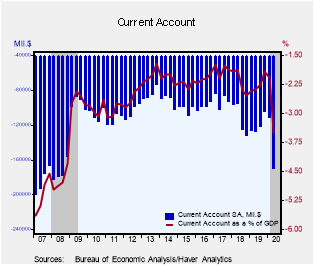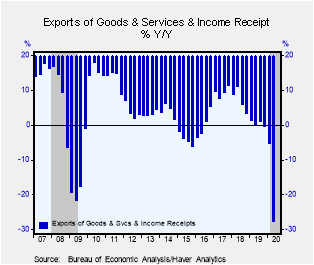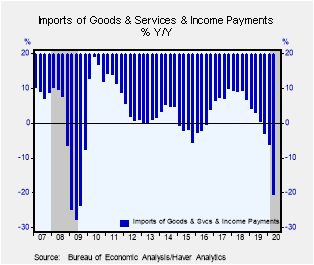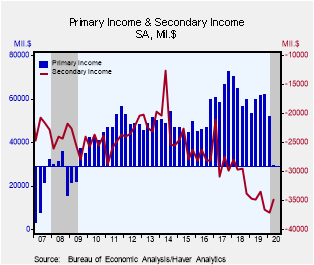 Global| Sep 18 2020
Global| Sep 18 2020U.S. Current Account Deficit Deepens Significantly in Q2
by:Tom Moeller
|in:Economy in Brief
Summary
• Current account deficit grows as exports & imports decline. • Goods & services balances both deteriorate. The U.S. current account deficit grew to $170.5 billion in Q2 2020 from $111.5 billion in Q1, revised from $104.2 billion. The [...]
• Current account deficit grows as exports & imports decline.
• Goods & services balances both deteriorate.
The U.S. current account deficit grew to $170.5 billion in Q2 2020 from $111.5 billion in Q1, revised from $104.2 billion. The Action Economics Forecast Survey anticipated a $159.0 billion deficit. As a percent of GDP, the deficit grew to 3.5%, it's deepest since Q4 2008.
The deficit in goods trade deteriorated to $219.3 billion as exports fell 28.4% (-29.7 y/y). All export categories realized significant declines led by a 58.9% drop (-61.6% y/y) in auto exports. Imports of goods also were off a sharp 14.6% (-20.0% y/y). Goods import declines were widespread with the largest being a 53.3% shortfall (-57.4% y/y) in auto imports.
Services exports declined 22.9% (-29.3% y/y) as travel exports weakened by two-thirds (-72.9% y/y). Export charges for the use of intellectual property fell 9.6% (-12.4% y/y. Imports of services weakened 25.9% (-31.5% y/y) reflecting an 89.7% drop (-92.6% y/y) in travel imports. Imports of charges for the use of intellectual property fell 12.8% (-6.6% y/y).
The surplus on primary income fell to $29.2 billion, the smallest since Q2 2009. Investment income receipts declined 18.4% (-27.3% y/y) while investment income payments weakened 11.7% (-21.0% y/y). The deficit on secondary income lessened slightly to $34.9 billion from its record $37.1 billion in Q1.
Balance of Payments data are in Haver's USINT database, with summaries available in USECON. The expectations figure is in the AS1REPNA database.
| US Balance of Payments SA | Q2'20 | Q1'20 | Q4'19 | 2019 | 2018 | 2017 |
|---|---|---|---|---|---|---|
| Current Account Balance ($ Billion) | -170.5 | -111.5 | -104.3 | -480.2 | -449.7 | -365.3 |
| Deficit % of GDP | -3.5 | -2.1 | -1.9 | -2.2 | -2.2 | -1.9 |
| Balance on Goods ($ Billion) | -219.3 | -191.7 | -202.5 | -864.3 | -880.3 | -799.3 |
| Exports (% Chg) | -28.4 | -1.9 | 0.1 | -1.5 | 7.7 | 6.8 |
| Imports (% Chg) | -14.6 | -3.0 | -2.9 | -1.6 | 8.5 | 6.8 |
| Balance on Services ($ Billion) | 54.4 | 65.3 | 72.7 | 287.5 | 300.4 | 285.6 |
| Exports (% Chg) | -22.9 | -8.6 | 0.8 | 1.6 | 3.9 | 6.4 |
| Imports (% Chg) | -25.9 | -7.8 | 0.4 | 4.7 | 3.2 | 6.4 |
| Balance on Primary Income ($ Billion) | 29.2 | 52.0 | 62.0 | 236.3 | 251.2 | 257.8 |
| Balance on Secondary Income ($ Billion) | -34.9 | -37.1 | -36.5 | -139.7 | -120.9 | -109.3 |
Tom Moeller
AuthorMore in Author Profile »Prior to joining Haver Analytics in 2000, Mr. Moeller worked as the Economist at Chancellor Capital Management from 1985 to 1999. There, he developed comprehensive economic forecasts and interpreted economic data for equity and fixed income portfolio managers. Also at Chancellor, Mr. Moeller worked as an equity analyst and was responsible for researching and rating companies in the economically sensitive automobile and housing industries for investment in Chancellor’s equity portfolio. Prior to joining Chancellor, Mr. Moeller was an Economist at Citibank from 1979 to 1984. He also analyzed pricing behavior in the metals industry for the Council on Wage and Price Stability in Washington, D.C. In 1999, Mr. Moeller received the award for most accurate forecast from the Forecasters' Club of New York. From 1990 to 1992 he was President of the New York Association for Business Economists. Mr. Moeller earned an M.B.A. in Finance from Fordham University, where he graduated in 1987. He holds a Bachelor of Arts in Economics from George Washington University.










